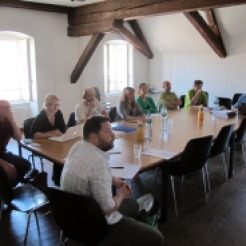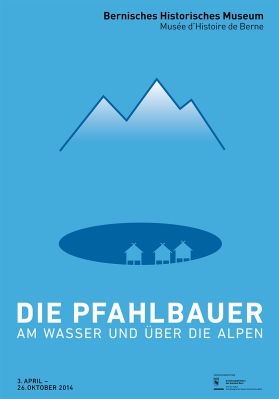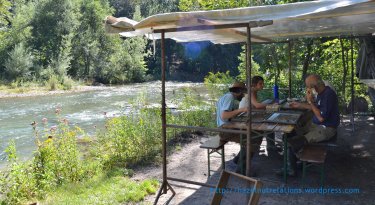It is already the last month of Doug’s Blogging Archaeology Carnival and although I have not been able to join in every month’s instalment, it has been great to see such a large part of the international archaeological blogging community come together and take part. However, it has been mostly bloggers from the English speaking world. And that is something I am a bit surprised about and I would really like to see changed. It would be fantastic to see more archaeologists from non-English speaking countries to start their own blogs and become more active on social media. So I would like to take the opportunity that Doug gave us by asking us where we are going with archaeological blogging or where we would like it to go and take stock of the archaeological social media and blogging situation in the country where I live and work: Switzerland.
Now, I am not sure I have not missed anything here or there, but as far I am aware there are at the moment, beside this blog, only two archaeological research blogs being actively maintained in Switzerland: kAltes Eis, the newest, and Silvretta Historica, which I helped set up in 2011. The Alpine Archaeology blog was part of a course I taught at the University of Zürich in 2011 and 2013. A facebookpage which resulted from that is still maintained by a few colleagues and me. The L’Arkeoblog is, as far as I know, the only other active personal partly archaeologically themed blog in Switzerland. Surprisingly, there no other personal research blogs by research students or other archaeologists that I know of, although I have noticed some MA-students and a few other archaeologists have started posting photos and other information about their research on facebook (e.g. MA dissertation). And the Universität Bern has a facebookpage for their training excavation in Buchs-Chammeren, canton Lucerne.
Quite some private archaeological and heritage firms and museums are present on social media, but most of their content is not research related and are limited to exhibition or event related items. To my amazement no Swiss archaeological university department or cantonal archaeological unit (who do most archaeological field and post-ex work) are present on social media, let alone maintain blogs. Especially the units are very active in public archaeology, but rely solely on the more traditional channels: the print media, TV and radio, as well as open days and guided tours. However, I have to say, when I worked for the Archaeological Service of the Canton of Berne, I was allowed to blog about my work with them here (see the posts here).
The reason for their absence on social media is, I believe, threefold: personal, resource related and the restrictive communication policies of the cantonal governments. To start with the personal, I have the impression that many Swiss archaeologists wrongly (!) do not consider themselves to be tech-savvy enough for using social media. Even the students I taught in two e-learning courses in the past 3 years had very little affinity with technology and social media, except for perhaps being on facebook. Most cantonal archaeological services, even in Switzerland, have limited resources and are struggling to do their core business and thus is an expansion of an, admittedly well-functioning, public archaeology strategy not a priority. Thirdly, the communication policies of the Cantons tends to be very restrictive and very much controlled by their communication departments. Hardly a written word leaves the offices without it having passed their scrutinising eyes. I even wonder if they would allow a blog or social media presence that is not maintained by them instead of the archaeologists themselves. But have a look at all the blogs that take part in this blogging carnival, people. There are so many things you can do with a blog and so many forms, aims, voices and audiences are to be had! Use it!
In the countries around us there are a few blogs from German archaeologists and I know of one Austrian blog. In France there are a few and in Italy there seems to be quite an active archaeological community on social media, esp. of young archaeologists. As an example, historians in the German-speaking world are much more active when it comes to blogging.
I like the way so many museums and other heritage institutions have embraced the possibilities of social media and the web and believe these are an essential tool for them these days. However, I love the personal blogs and social media efforts of individual researchers even more and would like to see more of these from non-English speaking countries (even if they would decide to write in English, as I have done). I believe – and with this I return to my first contribution to the blogging carnival – this could be increased if employers, whether university departments or cantonal units, would start to see the value of this work and would support it.
So, if there are among you readers out there archaeologists who blog or are active on social media but I have not discovered yet, I would love to hear from you. And if you are an archaeologist, a student, academic or in a unit and you would like to join us by starting a blog, a twitter account, pinterest page or anything else, but don’t know where to start, get in touch with any of us. We’re a friendly bunch, really!
The last words here, though, should be dedicated to thanking Doug for organising this Blogging Carnival and congratulating him on the success of it!
 Glacial archaeologists from Switzerland and Italy met last May in Berne and the meeting resulted in quite a bit of media interest. The meeting was innitiated by the L’Académie suisse des sciences humaines et sociales (ASSH/SAGW) and they have set up a website with with a number of ressources concerning the meeting and glacial and ice-patch archaeology. Do have a look, esp. also at the glacial archaeology dossier in their Bulletin (2/2019)! And certainly not just because I was also fortunate to be allowed to contribute something about the so far little known “Fuorcla da Strem Sut”-site, the oldest glacial archaeological site from the Alps, dating back to the Mesolithic.
Glacial archaeologists from Switzerland and Italy met last May in Berne and the meeting resulted in quite a bit of media interest. The meeting was innitiated by the L’Académie suisse des sciences humaines et sociales (ASSH/SAGW) and they have set up a website with with a number of ressources concerning the meeting and glacial and ice-patch archaeology. Do have a look, esp. also at the glacial archaeology dossier in their Bulletin (2/2019)! And certainly not just because I was also fortunate to be allowed to contribute something about the so far little known “Fuorcla da Strem Sut”-site, the oldest glacial archaeological site from the Alps, dating back to the Mesolithic. 
















